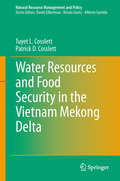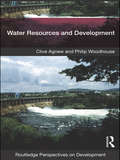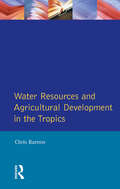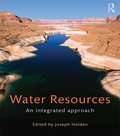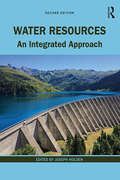- Table View
- List View
Water Resources in Algeria - Part II: Water Quality, Treatment, Protection and Development (The Handbook of Environmental Chemistry #98)
by Abdelazim M. Negm Abdelkader Bouderbala Haroun Chenchouni Damià BarcelóThis book reviews the latest water quality protection and water resources development strategies in Algeria. It covers topics such as the assessment and prediction of water quality, salt-water intrusion, treatment of wastewater for reuse, and desalination as an alternative source of water. The methods presented in this book can also be applied in other regions with similar climate conditions. Together with the companion volume Water Resources in Algeria - Part I: Assessment of Surface and Groundwater Resources, this book provides researchers with essential reference material on tools and techniques for water quality assessment, treatment, reuse, desalination, protection, and development, and offers a valuable resource for engineers, graduate students and policymakers who are interested in sustainable water resources.
Water Resources in Algeria - Part I: Assessment of Surface and Groundwater Resources (The Handbook of Environmental Chemistry #97)
by Abdelazim M. Negm Abdelkader Bouderbala Haroun Chenchouni Damià BarcelóThis book reviews the latest information on the assessment of surface and groundwater resources in Algeria. The authors cover a large diversity of topics, including the status and assessment of water resources, impacts of pesticides, soil droughts, analysis of flood characteristics, hydrogeological investigations and modeling applications, and evapotranspiration. Special attention is given to the impacts of climate changes on water resources. The assessment methods present in this book can be used or adapted to study other regions of North Africa, Middle East and/or in the Mediterranean with similar climate conditions as Algeria.This book and the companion volume Water Resources in Algeria - Part II: Water Quality, Treatment, Protection and Development will appeal to engineers, researchers, graduate students and policymakers interested in the field of groundwater and surface water assessment.
Water Resources and Integrated Management of the United Arab Emirates (World Water Resources #3)
by Abdulrahman S. Alsharhan Zeinelabidin E. RizkThis book provides an inventory of water resources, describes water challenges, and suggests methodologies and technologies for integrated water resources management in the UAE. It also summarizes efforts of water conservation and management, and modern approaches for improvement of water resources management and decision-making related to this valuable resource. The authors are specialized in geology and hydrogeology and have been teaching and conducting scientific research on water resources in the UAE for the last three decades. This book represents the main reference on water resources in the UAE for academia, researchers, professionals, students and the general public.
Water Resources and Hydrometeorology of the Arab Region (Water Science and Technology Library #59)
by Mamdouh ShahinThis book gives a unique portrait of the water resources in the Arab region dealing with climate and hydrology. It provides a historical introduction, physiographic features and geological settings of the region and its climate. The book deals with storage of water and impacts of water scarcity on the region’s future. There are reviews of topics coupled with case studies, data analyses, discussions and conclusions.
Water Resources and Food Security in the Vietnam Mekong Delta (Natural Resource Management and Policy #44)
by Tuyet L. Cosslett Patrick D. CosslettThe Mekong River has been a main source of conquest, conflict, and cooperation in the Southeast Asian region. Much has been written on the vital and critical importance of the Mekong River fresh water to the sustainable economic development of the Mekong Delta. This book selects the Mekong Delta as a case study of regional cooperation for water and food security for not only for Vietnam but also for the world in a new century of global economy. It focuses not only on the Mekong Delta as an integral part of the River but also on Can Tho City and its 12 provinces that produce over 50 percent of the country’s rice output and 60 percent of total fishery output. The book takes a micro approach to examine how each province is adapting to the twin threats of mainstream dams construction and climate change, reducing fresh water flows and increasing saline infusions on its present and future economy. Finally, it reviews the roles of international institutional arrangements, namely the Mekong Committee and the Mekong River Commission, in promoting regional cooperation among the riparian states for political and economic development of the Mekong Delta.
Water Resources and Environmental Engineering II: Climate and Environment
by Maheswaran Rathinasamy S. Chandramouli K.B.V.N. Phanindra Uma MaheshThe second volume of this book is a compilation of the high-quality papers from the International Conference on Emerging Trends in Water Resources and Environmental Engineering (ETWREE 2017). Written by researchers and academicians from prestigious institutes across India, the contributions present various scenarios and discuss the challenges of climate change and its impact on the environment, water resources and industrial and socio-economic developments. The book is a valuable resource for scientists, faculties, policymakers, and stakeholders working in the field of climate and environment management to address the current global environmental challenges.
Water Resources and Environmental Engineering I: Surface and Groundwater
by Maheswaran Rathinasamy S. Chandramouli K. B. V. N. Phanindra Uma MaheshThe book is a compilation of the papers presented in the International Conference on Emerging Trends in Water Resources and Environmental Engineering (ETWREE 2017). The high quality papers are written by research scholars and academicians of prestigious institutes across India. The book discusses the challenges of water management due to misuse or abuse of water resources and the ever mounting challenges on use, reuse and conservation of water. It also discusses issues of water resources such as water quantity, quality, management and planning for the benefits of water resource scientists, faculties, policy makers, stake holders working in the water resources planning and management. The research content discussed in the book will be helpful for engineers to solve practical day to day problems related to water and environmental engineering.
Water Resources and Environment: Proceedings of the 2015 International Conference on Water Resources and Environment (Beijing, 25-28 July 2015)
by Yuanyuan Kuai Miklas ScholzThe 2015 International Conference on Water Resource and Environment (WRE2015) aims to provide a platform where scholars from different countries can exchange ideas, opinions and views. This book is divided into four main themes:1. Hydrology and water resources;2. Water pollution; 3. Water treatment methods, and4. Freshwater ecosystems. Exploring to
Water Resources and Development
by Clive Agnew Philip WoodhouseSince the start of the twenty-first century there has been an unprecedented focus upon water as a key factor in the future of both society and environment. Water management lies at the heart of strategies of development as does the added the hazard of climate change. Water Resources and Development provides a stimulating interdisciplinary introduction to the role of water resources in shaping opportunities and constraints for development. The book begins by charting the evolution of approaches to water management. It identifies an emerging polarization in the late twentieth century between ‘technical’ and ‘social’ strategies. In the past decade these two axes of policy debate have been further intersected by discussion of the scale at which management decisions should be made: the relative effectiveness of ‘global’ and ‘local’ governance of water. A variety of case studies elaborate this analytical framework, exemplifying four key development challenges: economic growth, poverty reduction, competition and conflict over water, and adaptation to climate change. Current ‘best practice’ for water management is examined, addressing strategies of water supply augmentation, the ecological implications of intensified use, and strategies of demand management guided by economic or political principles. It is argued defining ‘successful’ water management and best practice requires first the establishment of development goals and the implicit trade-offs between water consumption and conservation. This engaging and insightful text offers a unique interdisciplinary analysis by integrating scientific, engineering, social and political perspectives. This is an essential text for courses on development studies, geography, earth sciences and the environment.
Water Resources and Development
by Clive Agnew Philip WoodhouseSince the start of the twenty-first century there has been an unprecedented focus upon water as a key factor in the future of both society and environment. Water management lies at the heart of strategies of development as does the added the hazard of climate change. Water Resources and Development provides a stimulating interdisciplinary introduction to the role of water resources in shaping opportunities and constraints for development. The book begins by charting the evolution of approaches to water management. It identifies an emerging polarization in the late twentieth century between ‘technical’ and ‘social’ strategies. In the past decade these two axes of policy debate have been further intersected by discussion of the scale at which management decisions should be made: the relative effectiveness of ‘global’ and ‘local’ governance of water. A variety of case studies elaborate this analytical framework, exemplifying four key development challenges: economic growth, poverty reduction, competition and conflict over water, and adaptation to climate change. Current ‘best practice’ for water management is examined, addressing strategies of water supply augmentation, the ecological implications of intensified use, and strategies of demand management guided by economic or political principles. It is argued defining ‘successful’ water management and best practice requires first the establishment of development goals and the implicit trade-offs between water consumption and conservation. This engaging and insightful text offers a unique interdisciplinary analysis by integrating scientific, engineering, social and political perspectives. This is an essential text for courses on development studies, geography, earth sciences and the environment.
Water Resources and Decision-Making Systems (Routledge Special Issues on Water Policy and Governance)
by Cecilia Tortajada Kevin ParrisWater data and information are essential to support efforts to understand, manage, allocate, utilize and protect water resources. The linkages between Water Information Systems and needs of decision makers are complex, but can be encapsulated in a Driving Force (Policy Needs) – Monitoring – Data Management – Reporting framework. The rapid development in water policy reforms in many sectors and growing emphasis on demand-side policy solutions to water resources management has created an information imbalance. This imbalance can be characterised in terms of an inverted pyramid with implementation of many water policy initiatives supported by little data and information, especially related to economic and financial elements, to help guide decision makers toward more effective and efficient water resources management strategies. Additionally, as stress and demands on water systems increase and water becomes a more valued resource, this tends to increase the value of water information both for water providers and users. Nevertheless, many countries are reporting that the capacity to collect water information is being undermined by a lack of resources, while expertise to collect, analyse and interpret water data for decision makers is being lost. Finally, the impact of climate change on hydrological regimes represents a key potential stress on water systems. This issue could be the catalyst for adapting policies to provide more efficient and effective use and management of water resources and advance institutional and governance reforms in the water sector.This book is based on a special issue of the International Journal of Water Resources Development.
Water Resources and Decision-Making Systems (Routledge Special Issues on Water Policy and Governance)
by Cecilia Tortajada Kevin ParrisWater data and information are essential to support efforts to understand, manage, allocate, utilize and protect water resources. The linkages between Water Information Systems and needs of decision makers are complex, but can be encapsulated in a Driving Force (Policy Needs) – Monitoring – Data Management – Reporting framework. The rapid development in water policy reforms in many sectors and growing emphasis on demand-side policy solutions to water resources management has created an information imbalance. This imbalance can be characterised in terms of an inverted pyramid with implementation of many water policy initiatives supported by little data and information, especially related to economic and financial elements, to help guide decision makers toward more effective and efficient water resources management strategies. Additionally, as stress and demands on water systems increase and water becomes a more valued resource, this tends to increase the value of water information both for water providers and users. Nevertheless, many countries are reporting that the capacity to collect water information is being undermined by a lack of resources, while expertise to collect, analyse and interpret water data for decision makers is being lost. Finally, the impact of climate change on hydrological regimes represents a key potential stress on water systems. This issue could be the catalyst for adapting policies to provide more efficient and effective use and management of water resources and advance institutional and governance reforms in the water sector.This book is based on a special issue of the International Journal of Water Resources Development.
Water Resources and Agricultural Development in the Tropics (Longman Development Studies)
by Christopher J. BarrowFirst published in 1988. There are many excellent texts on water supply and irrigation engineering, irrigation economics, agricultural development and the problems which often plague such efforts. Few syntheses of such writings have been made, despite a clear need for them from people interested in water resources and agricultural development: students of geography, economics, development studies and agricultural management, administrators, planners and aid agency staff. This book attempts to provide a broad interdisciplinary introduction for such people.
Water Resources and Agricultural Development in the Tropics (Longman Development Studies)
by Christopher J. BarrowFirst published in 1988. There are many excellent texts on water supply and irrigation engineering, irrigation economics, agricultural development and the problems which often plague such efforts. Few syntheses of such writings have been made, despite a clear need for them from people interested in water resources and agricultural development: students of geography, economics, development studies and agricultural management, administrators, planners and aid agency staff. This book attempts to provide a broad interdisciplinary introduction for such people.
Water Resources: An Integrated Approach
by Joseph HoldenThe world faces huge challenges for water as population continues to grow, as emerging economies develop and as climate change alters the global and local water cycle. There are major questions to be answered about how we supply water in a sustainable and safe manner to fulfil our needs, while at the same time protecting vulnerable ecosystems from disaster. Water Resources: An Integrated Approach provides students with a comprehensive overview of both natural and socio-economic processes associated with water. The book contains chapters written by 20 specialist contributors, providing expert depth of coverage to topics. The text guides the reader through the topic of water starting with its unique properties and moving through environmental processes and human impacts upon them including the changing water cycle, water movement in river basins, water quality, groundwater and aquatic ecosystems. The book then covers management strategies for water resources, water treatment and re-use, and the role of water in human health before covering water economics and water conflict. The text concludes with a chapter that examines new concepts such as virtual water that help us understand current and future water resource use and availability across interconnected local and global scales. This book provides a novel interdisciplinary approach to water in a changing world, from an environmental change perspective and inter-related social, political and economic dimensions. It includes global examples from both the developing and developed world. Each chapter is supplemented with boxed case studies, end of chapter questions, and further reading, as well as a glossary of terms. The text is richly illustrated throughout with over 150 full colour diagrams and photos.
Water Resources: An Integrated Approach
by Joseph HoldenThe world faces huge challenges for water as population continues to grow, as emerging economies develop and as climate change alters the global and local water cycle. There are major questions to be answered about how we supply water in a sustainable and safe manner to fulfil our needs, while at the same time protecting vulnerable ecosystems from disaster. Water Resources: An Integrated Approach provides students with a comprehensive overview of both natural and socio-economic processes associated with water. The book contains chapters written by 20 specialist contributors, providing expert depth of coverage to topics. The text guides the reader through the topic of water starting with its unique properties and moving through environmental processes and human impacts upon them including the changing water cycle, water movement in river basins, water quality, groundwater and aquatic ecosystems. The book then covers management strategies for water resources, water treatment and re-use, and the role of water in human health before covering water economics and water conflict. The text concludes with a chapter that examines new concepts such as virtual water that help us understand current and future water resource use and availability across interconnected local and global scales. This book provides a novel interdisciplinary approach to water in a changing world, from an environmental change perspective and inter-related social, political and economic dimensions. It includes global examples from both the developing and developed world. Each chapter is supplemented with boxed case studies, end of chapter questions, and further reading, as well as a glossary of terms. The text is richly illustrated throughout with over 150 full colour diagrams and photos.
Water Resources: An Integrated Approach
by Joseph HoldenNow in its second edition, Water Resources: An Integrated Approach provides students with a comprehensive overview of natural processes associated with water and the modifications of these processes by humans through climate change and land management, water-related health issues, engineering approaches to water and socio-economic processes of huge importance to water resources. The book contains chapters written by 24 specialist contributors, providing expert depth of coverage to topics. The text introduces the basic properties of water and its importance to society and the nature of the different regional imbalances between water resource availability and demand. It guides the reader through the changing water cycle impacted by climate and land management, water flows in river basins, surface water quality, groundwater and aquatic ecosystems, and covers the role of water in human health and associated hazards before turning to engineering solutions to water and wastewater treatment and reuse. The book deals with physical and social management strategies required for water resource planning, the economics of water and treatment of issues associated with conflict over water. The concept of virtual water is covered before the text concludes with a chapter considering the challenges of predicting future water issues in a rapidly changing world and where environmental systems can behave in a non-linear way. The need to work across disciplines to address challenges that are connected at both local and global scales is highlighted. Water Resources also includes global examples from both the developing and developed world. There are 58 case study boxes. Each chapter is supplemented with these case studies and with reflective questions, project ideas and further reading, as well as links to a glossary of terms. The book is richly illustrated throughout with over 160 full-colour diagrams and photographs. The text provides a novel interdisciplinary approach to water in a changing world, from an environmental change perspective and interrelated social, political and economic dimensions. It will be an indispensable guide to undergraduates studying Water Resources and Management, Geography of Water, and Water in the Environment.
Water Resources: An Integrated Approach
by Joseph HoldenNow in its second edition, Water Resources: An Integrated Approach provides students with a comprehensive overview of natural processes associated with water and the modifications of these processes by humans through climate change and land management, water-related health issues, engineering approaches to water and socio-economic processes of huge importance to water resources. The book contains chapters written by 24 specialist contributors, providing expert depth of coverage to topics. The text introduces the basic properties of water and its importance to society and the nature of the different regional imbalances between water resource availability and demand. It guides the reader through the changing water cycle impacted by climate and land management, water flows in river basins, surface water quality, groundwater and aquatic ecosystems, and covers the role of water in human health and associated hazards before turning to engineering solutions to water and wastewater treatment and reuse. The book deals with physical and social management strategies required for water resource planning, the economics of water and treatment of issues associated with conflict over water. The concept of virtual water is covered before the text concludes with a chapter considering the challenges of predicting future water issues in a rapidly changing world and where environmental systems can behave in a non-linear way. The need to work across disciplines to address challenges that are connected at both local and global scales is highlighted. Water Resources also includes global examples from both the developing and developed world. There are 58 case study boxes. Each chapter is supplemented with these case studies and with reflective questions, project ideas and further reading, as well as links to a glossary of terms. The book is richly illustrated throughout with over 160 full-colour diagrams and photographs. The text provides a novel interdisciplinary approach to water in a changing world, from an environmental change perspective and interrelated social, political and economic dimensions. It will be an indispensable guide to undergraduates studying Water Resources and Management, Geography of Water, and Water in the Environment.
Water Resources: Science and Society
by George M. Hornberger Debra PerroneThe fair allocation and wise use of fresh water presents significant challenges across the world. To avoid unresolvable crises in the future, judiciously managing water resources in the twenty-first century is fundamentally important. Integrating the underlying science of hydrology with real-world usage scenarios, Water Resources offers a nuanced, modern treatment of contemporary water resource management issues.In this ground-breaking new text, renowned environmental scientist and educator George M. Hornberger and award-winning environmental engineer Debra Perrone examine the role of water resources in natural, social, and human-built systems, helping students understand and evaluate the complex tradeoffs required to achieve sustainable water management. Providing a much-needed educational tool that looks at freshwater resources within the context of the crucial water-energy-food nexus, the text • includes a primer on the elements of physical hydrology necessary to understand resource availability; • covers rivers, lakes, groundwater, and soil water;• relates water to agriculture, energy, urbanization, and the environment;• highlights connections between water quantity and quality; • explains the economic and legal constraints around water resources; • considers the impacts of climate change and population growth; and• proposes paths forward for the sustainable use of water.Teaching basic methods used to make informed water management decisions, the book includes illustrative quantitative calculations, qualitative think-pieces, and case studies. An appendix provides a review of units, dimensions, and conversions useful for addressing each chapter's example problems. Online answer keys are also available.Positioned to become the foremost text on water resource issues, this companion to Hornberger's widely regarded Elements of Physical Hydrology reveals the enormity of the water crisis facing the planet while offering realistic hope.
Water Resources: Science and Society
by George M. Hornberger Debra PerroneThe fair allocation and wise use of fresh water presents significant challenges across the world. To avoid unresolvable crises in the future, judiciously managing water resources in the twenty-first century is fundamentally important. Integrating the underlying science of hydrology with real-world usage scenarios, Water Resources offers a nuanced, modern treatment of contemporary water resource management issues.In this ground-breaking new text, renowned environmental scientist and educator George M. Hornberger and award-winning environmental engineer Debra Perrone examine the role of water resources in natural, social, and human-built systems, helping students understand and evaluate the complex tradeoffs required to achieve sustainable water management. Providing a much-needed educational tool that looks at freshwater resources within the context of the crucial water-energy-food nexus, the text • includes a primer on the elements of physical hydrology necessary to understand resource availability; • covers rivers, lakes, groundwater, and soil water;• relates water to agriculture, energy, urbanization, and the environment;• highlights connections between water quantity and quality; • explains the economic and legal constraints around water resources; • considers the impacts of climate change and population growth; and• proposes paths forward for the sustainable use of water.Teaching basic methods used to make informed water management decisions, the book includes illustrative quantitative calculations, qualitative think-pieces, and case studies. An appendix provides a review of units, dimensions, and conversions useful for addressing each chapter's example problems. Online answer keys are also available.Positioned to become the foremost text on water resource issues, this companion to Hornberger's widely regarded Elements of Physical Hydrology reveals the enormity of the water crisis facing the planet while offering realistic hope.
Water Resources: A New Water Architecture (Challenges in Water Management Series)
by Alexander Lane Michael Norton Sandra RyanOver 7 billion people demand water from resources that the changing climate is making more and more difficult to harness. Water scarcity and shortage are increasingly common and conditions are becoming more extreme. Inadequate and inappropriate management of water is already taking its toll on the environment and on the quality of life of millions of people. Modern water professionals have a duty to develop sound water science and robust evidence to lobby and influence national and regional development policy and investment priorities. We need to be bold and brave to challenge the status quo, argue the case for change, and create a New Water Architecture. Water Resources: A New Water Architecture takes a unique approach to the challenges of water management. The stress caused by our desire to live, eat, and consume is examined in the context of Governance, the role of policy, and the commercial world. The authors share their nine-step vision for a New Water Architecture. Written by three industry practitioners, this book provides students, young professionals, policymakers, and those interested in the sustainability of our natural resources with a pragmatic and compelling perspective on how to manage the ultimate resource of our time.
Water Resources: A New Water Architecture (Challenges in Water Management Series)
by Alexander Lane Michael Norton Sandra RyanOver 7 billion people demand water from resources that the changing climate is making more and more difficult to harness. Water scarcity and shortage are increasingly common and conditions are becoming more extreme. Inadequate and inappropriate management of water is already taking its toll on the environment and on the quality of life of millions of people. Modern water professionals have a duty to develop sound water science and robust evidence to lobby and influence national and regional development policy and investment priorities. We need to be bold and brave to challenge the status quo, argue the case for change, and create a New Water Architecture. Water Resources: A New Water Architecture takes a unique approach to the challenges of water management. The stress caused by our desire to live, eat, and consume is examined in the context of Governance, the role of policy, and the commercial world. The authors share their nine-step vision for a New Water Architecture. Written by three industry practitioners, this book provides students, young professionals, policymakers, and those interested in the sustainability of our natural resources with a pragmatic and compelling perspective on how to manage the ultimate resource of our time.
Water Resource Systems Planning and Management: An Introduction to Methods, Models, and Applications (Studies And Reports In Hydrology)
by Daniel P. Loucks Eelco Van BeekThis book is open access under a CC BY-NC 4.0 license.This revised, updated textbook presents a systems approach to the planning, management, and operation of water resources infrastructure in the environment. Previously published in 2005 by UNESCO and Deltares (Delft Hydraulics at the time), this new edition, written again with contributions from Jery R. Stedinger, Jozef P. M. Dijkman, and Monique T. Villars, is aimed equally at students and professionals. It introduces readers to the concept of viewing issues involving water resources as a system of multiple interacting components and scales. It offers guidelines for initiating and carrying out water resource system planning and management projects. It introduces alternative optimization, simulation, and statistical methods useful for project identification, design, siting, operation and evaluation and for studying post-planning issues. The authors cover both basin-wide and urban water issues and present ways of identifying and evaluating alternatives for addressing multiple-purpose and multi-objective water quantity and quality management challenges. Reinforced with cases studies, exercises, and media supplements throughout, the text is ideal for upper-level undergraduate and graduate courses in water resource planning and management as well as for practicing planners and engineers in the field.
Water Resource Management Issues: Basic Principles and Applications
by Louis Theodore R. Ryan DupontDrinking Water Safety: Basic Principles and Applications, examines the technical and scientific, as well as regulatory, ethical, and emerging issues of pollution prevention, sustainability, and optimization for the production and management of safe drinking water to cope with environmental pollution, population growth, increasing demand, terrorist threats, and climate change pressures. It presents a summary of conventional water and wastewater treatment technologies, in addition to the latest processes. Features include: Provides a summary of current and future of global water resources and availability. Summarizes key U.S. regulatory programs designed to ensure protection of water quality and safe drinking water supplies, with details on modern approaches for water utility resilience. Examines the latest water treatment technologies and processes, including separate chapters on evaporation, crystallization, nanotechnology, membrane-based processes, and innovative desalination approaches. Reviews the specialized literature on pollution prevention, sustainability, and the role of optimization in water treatment and related areas, as well as references for further reading. Provides illustrative examples and case studies that complement the text throughout, as well as an appendix with sections on units and conversion constants.





